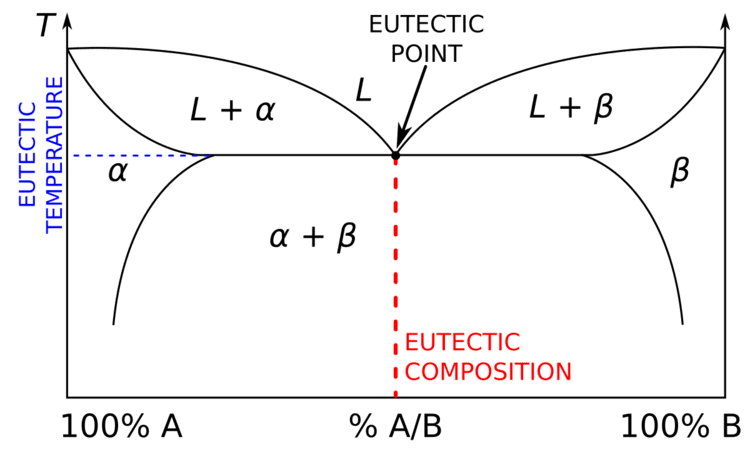 | ||
A eutectic system (/juːˈtɛktɪk/ yew-TEK-tik) from the Greek "ευ" (eu = easy) and "Τήξις" (teksis = melting) describes a homogeneous solid mix of atomic and/or chemical species, forming a joint super-lattice, by striking a unique atomic percentage ratio between the components — as each pure component has its own distinct bulk lattice arrangement. It is only in this atomic/molecular ratio that the eutectic system melts as a whole, at a specific temperature (the eutectic temperature) the super-lattice releasing at once all its components into a liquid mixture. The eutectic temperature is the lowest possible melting temperature over all of the mixing ratios for the involved component species.
Contents
- Eutectic reaction
- Non eutectic compositions
- Alloys
- Others
- Eutectoid
- Peritectoid
- Peritectic
- Eutectic calculation
- References
Upon heating any other mixture ratio, and reaching the eutectic temperature — see the adjacent phase diagram — one component's lattice will melt first, while the temperature of the mixture has to further increase for (all) the other component lattice(s) to melt. Conversely, as a non-eutectic mixture cools down, each mixture's component will solidify (form its lattice) at a distinct temperature, until all material is solid.
The coordinates defining a eutectic point on a phase diagram are the eutectic percentage ratio (on the atomic/molecular ratio axis of the diagram) and the eutectic temperature (on the temperature axis of the diagram).
Not all binary alloys have eutectic points because the valence electrons of the component species are not always compatible, in any mixing ratio, to form a new type of joint crystal lattice. For example, in the silver-gold system the melt temperature (liquidus) and freeze temperature (solidus) "meet at the pure element endpoints of the atomic ratio axis while slightly separating in the mixture region of this axis".
Eutectic reaction
The eutectic reaction is defined as follows:
This type of reaction is an invariant reaction, because it is in thermal equilibrium; another way to define this is the Gibbs free energy equals zero. Tangibly, this means the liquid and two solid solutions all coexist at the same time and are in chemical equilibrium. There is also a thermal arrest for the duration of the change of phase during which the temperature of the system does not change.
The resulting solid macrostructure from a eutectic reaction depends on a few factors. The most important factor is how the two solid solutions nucleate and grow. The most common structure is a lamellar structure, but other possible structures include rodlike, globular, and acicular.
Non-eutectic compositions
Compositions of eutectic systems that are not at the eutectic composition can be classified as hypoeutectic or hypereutectic. Hypoeutectic compositions are those with a smaller percent composition of species β and a greater composition of species α than the eutectic composition (E) while hypereutectic solutions are characterized as those with a higher composition of species β and a lower composition of species α than the eutectic composition. As the temperature of a non-eutectic composition is lowered the liquid mixture will precipitate one component of the mixture before the other. In a hypereutectic solution, there will be a proeutectoid phase of species β whereas a hypoeutectic solution will have a proeutectic α phase.
Alloys
Eutectic alloys have two or more materials and have a eutectic composition. When a non-eutectic alloy solidifies, its components solidify at different temperatures, exhibiting a plastic melting range. Conversely, when a well-mixed, eutectic alloy melts, it does so at a single, sharp temperature. The various phase transformations that occur during the solidification of a particular alloy composition can be understood by drawing a vertical line from the liquid phase to the solid phase on the phase diagram for that alloy.
Some uses include:
Others
Eutectoid
When the solution above the transformation point is solid, rather than liquid, an analogous eutectoid transformation can occur. For instance, in the iron-carbon system, the austenite phase can undergo a eutectoid transformation to produce ferrite and cementite, often in lamellar structures such as pearlite and bainite. This eutectoid point occurs at 727 °C (1,341 °F) and about 0.76% carbon.
Peritectoid
A peritectoid transformation is a type of isothermal reversible reaction that has two solid phases reacting with each other upon cooling of a binary, ternary, ...,
Peritectic
Peritectic transformations are also similar to eutectic reactions. Here, a liquid and solid phase of fixed proportions react at a fixed temperature to yield a single solid phase. Since the solid product forms at the interface between the two reactants, it can form a diffusion barrier and generally causes such reactions to proceed much more slowly than eutectic or eutectoid transformations. Because of this, when a peritectic composition solidifies it does not show the lamellar structure that is found with eutectic solidification.
Such a transformation exists in the iron-carbon system, as seen near the upper-left corner of the figure. It resembles an inverted eutectic, with the δ phase combining with the liquid to produce pure austenite at 1,495 °C (2,723 °F) and 0.17% carbon.
At the peritectic decomposition temperature the compound, rather than melting, decomposes into another solid compound and a liquid. The proportion of each is determined by the lever rule. In the Al-Au phase diagram, for example, it can be seen that only two of the phases melt congruently, AuAl2 and Au2Al , while the rest peritectically decompose.
Eutectic calculation
The composition and temperature of a eutectic can be calculated from enthalpy and entropy of fusion of each components.
The Gibbs free energy, G, depends on its own differential
Thus, the G/T derivative at constant pressure is calculated by the following equation
The chemical potential
At the equilibrium,
Using and integrating gives
The integration constant K may be determined for a pure component with a melting temperature
We obtain a relation that determines the molar fraction as a function of the temperature for each component.
The mixture of n components is described by the system
that can be solved by
